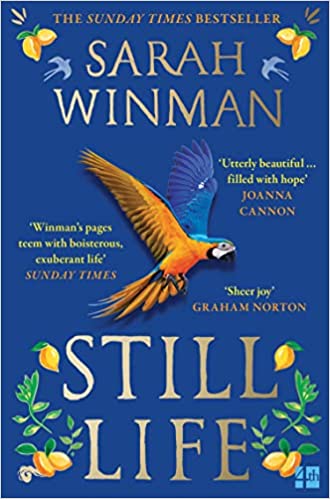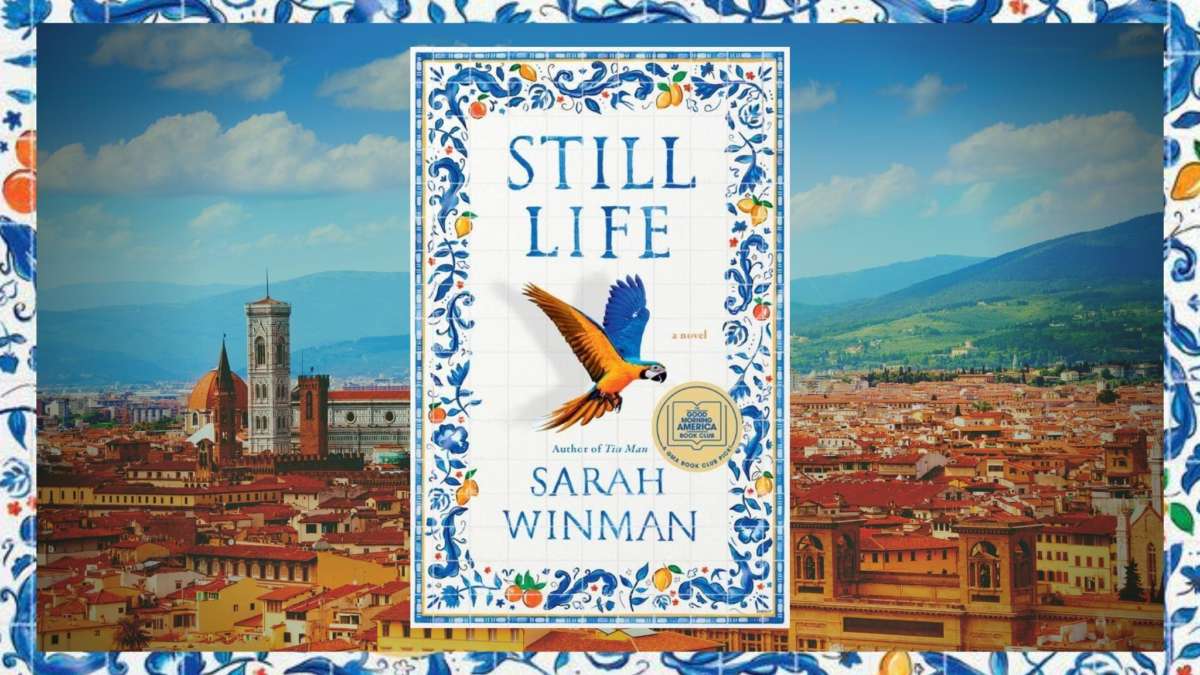Still Life by Sarah Winman
If you had the opportunity to read Tin Man, a beautiful story of love, loss and art by Sarah Winman and loved it like I did, then you cannot miss Still Life, her latest novel!
Still Life is a lovely meandering through lives well-lived where the eclectic characters choose their family, spend time supporting each other and live a challenging, yet fulfilling, life. The story takes place in an English pub (where struggles are the norm) and the romantic, historic, winding streets of Florence (where everything feels possible).
LOVE IN, AND AFTER, WAR
In 1940s war-torn Italy, Ulysses Temper, a young English soldier, and Evelyn Skinner, an art historian in her mid-sixties, have a chance meeting where they share wisdom and bond in an abandoned villa’s wine cellar. After the war, Ulysses returns to his life in London and to his East End neighborhood bar, The Stoat and Parrot, with his oddball friends. But he never forgets Evelyn, the memories they shared and the beauty of Italy. When an unexpected inheritance allows him the opportunity to return to Italy, Ulysses begins a new adventure, taking his friends who are family along for the ride.
Starting fresh, faced with births, deaths and the flood of 1966, Ulysses and his self-made family experience life. From a charming bed and breakfast to the Florence piazzas, author Sarah Winman takes us on a beautiful journey of love, loss, art and food – just what one would expect from an Italian getaway! She has an incredible way with characters where you feel their emotions, get invested in their relationships and experience the world through their eyes. With unexpected humor brought in with Claude, a Shakespeare-quoting trained parrot, and a wistful feeling that those who are meant to be together keep missing each other by a hair, Still Life is a wonderful story of people who experience war, disappointments, natural disasters and loss, yet find a way to live a full spectrum of a beautiful life infused with love and happiness. This is a perfect book to get immersed in and one to savor! I loved it!
Q&A WITH SARAH WINMAN
Q: I fell in love with your writing in 2017 when I read Tin Man and was so moved by the beautiful story of love draped in sadness. This paradox of a complex life filled with wonderful relationships along with loneliness and loss is your sweet spot when it comes to storytelling. Is it a calculated choice to write about the full spectrum of experiences and emotions in your books?
A: I suppose I write what I like to read. And what I like to watch. I like to feel moved. It connects me to people. I like to care about the people I’m reading about or watching on stage or in the cinema. I also believe within the writing I am sorting things out in my own life. Confronting aspects of the past, maybe. I have walked enough miles, now, to understand the complexity and vulnerability of our humanness. That to me is rich territory.
Q: For me, Still Life is a love letter to Italy, as I enjoyed meandering around Florence, drinking wine and eating pasta with your characters and throughout your pages. Why did you set the story there and how did you do research to know the lay of the land?
A: Back in 2015, as the culmination of a basic Renaissance Art course I’d recently completed at the National Gallery in London, I went to Florence for 10 days. I was having a late lunch in a neighbourhood restaurant there when I noticed on the walls, photographs of Florence underwater – what I came to know as the flood of 1966. The owner brought out books for me to look at and told me about the Mud Angels, the young men and women who flocked to the city to help clean up. That was the moment the story came to me and wouldn’t let me go. It was a romantic catch, and it fascinated me. I then spent a few years trying to push the story away as it all felt a bit daunting writing about a city that I didn’t know. And also, did the world need another book on Florence?
But as I began to travel back and forth there and began to read many books and meet English people who had moved there, slowly a pathway opened up.
Q: The scenes that take place in the bar in London feel so authentic. Is that location based on a real bar?
A: No it’s not! It’s simply how I imagined a pub would be during that time. But the area of London I placed it in was demolished in the ’60s and ’70s. So it has a ghostly presence.
Q: Claude, the talking parrot, made me laugh, brought some cheer to an old bar and added a lighthearted aspect to the book; can you share how you came up with the idea to include him (and not just a dog)?
A: Claude was initially included as a comedic foil. Pubs or homes in the area often had birds because there was a historic bird market nearby in Club Row – probably a leftover influence of the Huguenots who once lived in the area. But then he became something more. The unspoken, perhaps?
Q: Ulysses is from London and after being a soldier in the war in Italy, he chooses to return there after the war to make a home. Most soldiers may not go back to the country where they observed or participated in war – why did you have him go back?
A: Quite a few soldiers stayed on in Europe or returned after the Second World War. Many had fallen in love. Many had little to go back to in England. I listened to oral stories that confirmed this. My grandfather was in the 8th army and came up from North Africa into Sicily and then up through Italy. He thought the country was beautiful. I think it was eye-opening for a working-class boy who had, up until then, little opportunity to travel.
Q: Evelyn Skinner is an art historian salvaging works of art in war-torn Italy in 1944 when she meets Ulysses as a young soldier and they form an unlikely connection. Why do you think they hit it off so well?
A: Because they give each other what they both need in that moment. They are both charismatic. Eloquent. War has made small talk irrelevant – they talk straight to the heart.
Q: Years later, every time their paths almost crossed my heart skipped a beat. When it comes to the writing process, how do you decide how many close calls are enough before they finally meet again?
A: Through trial and error, mostly. There is an instinctive beat to the writing. I read the pages over and over and monitor how I feel as I read. Am I bored? Dragging something out? Editors are also invaluable for moments like this.
Q: You have included art in your writing before. What is your connection to works of art and why are they important to you?
A: Art is important to me. As Evelyn says: Beautiful art opens our eyes to the beauty of the world. It repositions sight and judgment. And to feel that response as we stand in front of a painting, or a sculpture, or a drawing – to know that it has been crafted by another human being – their experience of life is part of that creation. Therein lies richness and gratitude for being alive.
Q: I love how you write about all different types of relationships, platonic and romantic, and they all feel real, natural and full of love. What inspires you to create these beautiful and accepting relationships we all should aspire to?
A: I write what I aspire to, what I believe is possible and what I have also witnessed. This book was written in answer to the hateful rhetoric and division stoked by my government in the wake of Brexit.
Q: In Still Life, you did a wonderful job writing about a group of friends who choose to be family. What inspired you to bring this motley crew together?
A: I wanted to write something joyous and entertaining. And that energy dictated how the group of friends would interact. I was also obsessed with a play at the time – Girl From the North Country – also set in a boarding house. And years ago, I remember finishing Tim Winton’s book Cloudstreet, and wondering if I could ever write a book like that – a multigenerational, theatrical ensemble kind of book.
Q: War is horrific and art is beautiful, Italy romantic and in some ways dreamlike when all the friends end up together, supporting each other. Still Life feels like a movie – how do you capture all of that in a book?
A: I love cinema. I get a lot of my understanding of storytelling from the moving image and consequently write with that influence. That’s how I see all my books: filmic.
Q: How long did it take you to write this book, did you cut anything out that you wish stayed in and who was your favorite character to write?
A: Still Life took about two and a half years to write and in the editing process I cut 17,500 words. I don’t regret any of the cuts. I think it was a brilliant edit by my editor. We did actually cut the narrator (!) but I won’t say too much about that, in case I put them in another book! My favourite character? Evelyn, I think.
Q: How has your acting experience impacted your writing?
A: Probably in the understanding of characterization, mostly. I read everything I write out loud to make sure the rhythm is correct.
Q: What are you working on now? Still Life feels like it could continue, any thoughts on a sequel?
A: I’m not working on anything at the moment, which isn’t so unusual. I often take my time between books.
I don’t think there is a sequel. I feel that the beautiful little contract I had with Florence is done. There is, however, room for more to be said about Evelyn, I think. But that would be quite a different book.
Q: What books have you read lately that you recommend?
A: The Love Songs of W.E.B. Du Bois by Honorée Fanonne Jeffers. It is magnificent.
Q: How can we follow you and keep up with all you are doing?
A: The best place would be Instagram.
Buy this Book!
Amazon



